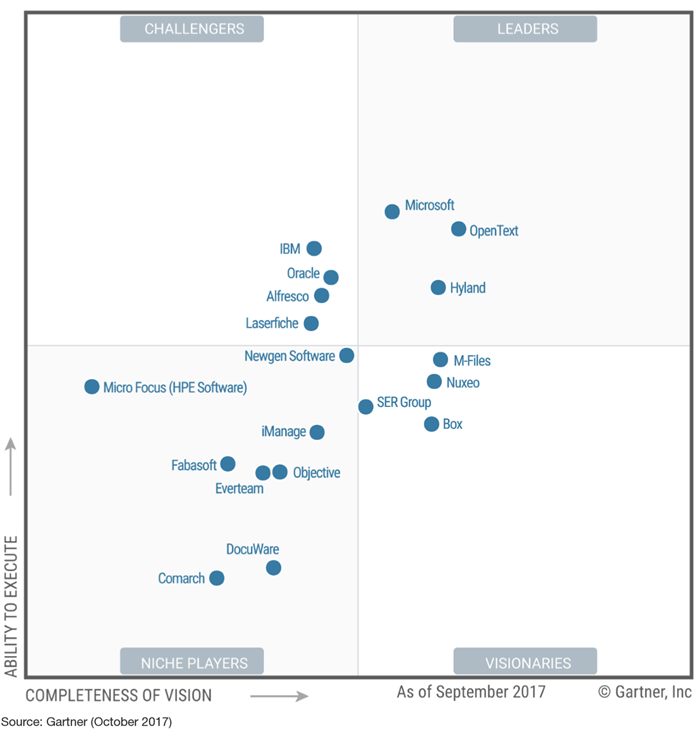A Closer Look at Gartner's MQ for Content Services Platforms (CSP)
By Venus Tamturk
October 12, 2017
Alfresco, content services, Enterprise, Enterprise Content Management, Exclusive Interviews, gartner, Hyland, Laserfiche, OpenText, research, SharePoint
This July, we discussed the Web Content Management (WCM) platforms in light of Gartner’s  Magic Quadrant (MQ) for WCM. Now it is time to bring Gartner’s little blue dots back as this month, they have once again wiggled around for the Content Services Platform (CSP) market.
Magic Quadrant (MQ) for WCM. Now it is time to bring Gartner’s little blue dots back as this month, they have once again wiggled around for the Content Services Platform (CSP) market.
According to Gartner, the CSP market has evolved from the Enterprise Content Management (ECM) market thus the Stamford, Conn.-based research firm included those that have been evaluated in previous Magic Quadrants for ECM as well as those that would not have classically fit into the ECM market unless they offer packaged solutions, focused on a single vertical market, were too geographically localized or delivered lighter-weight content services functionality, among others. More importantly, Gartner predicts that 20% of major EFSS and ECM vendors will transform their existing offerings into content service platforms, while 15% of enterprises will have replaced their traditional ECM provider with a provider that offers consumerlike content services by 2020.
Not only does this article discuss who’s in, who’s out, and what the significant vendors have been up to lately as well as my commentary on those occurrences but it also includes exclusive comments from the leading vendors' executives on their inclusion as well as their plans for the growth opportunities that the Gartner analysts pointed out in the report.
In the report, the market research firm evaluated 19 vendors on 15 criteria, grouped by Ability to Execute and Completeness of Vision. Below are how those platforms stack up in the report:
-
Leaders: Microsoft, OpenText, and Hyland
-
Challengers: IBM, Oracle, Alfresco, and Laserfiche
-
Visionaries: M-Files, Nuxeo, SER Group, and Box
-
Niche Players: Newgen Software, Micro Focus, iManage, Fabasoft, Everteam, Objective, Docuware, and Comarch

OpenText
OpenText, a Canadian enterprise information management vendor, offers two CSPs — its long-standing Content Suite and Documentum, which it acquired from Dell EMC for $1.62 billion. Prior to the acquisition, the Waterloo, Ontario-based enterprise information management provider had rolled out a major product upgrade; OpenText Content Suite 16. With this major update, the vendor provided personalized experiences through the new simple and responsive user interface with role-based views. As a result, the vendors’ customers have expressed high levels of satisfaction with OpenText Content Suite’s integration capabilities, life-cycle management, and overall foundational library services. I was wondering if Gartner’s report cited anything about Documentum clients’ concern for the on-going integration of the Documentum product family with OpenText’s portfolio but in the report, there hasn’t been any concern mentioned in that respect. With its Innovation Tour across the globe and enthusiastic statements made by OpenText executives, they may have finally banished the doubts coming from a somewhat distrusting user base after all.
Interview with the Senior Director, Enterprise Product Marketing at OpenText
Following the release of this newly created MQ report, I reached out to Stephen Ludlow, Senior Director, Enterprise Product Marketing, first, to pick his brain on what this placement indicates for OpenText: “The recognition from Gartner is a reflection of our ability to execute and our strategy and completeness of vision. The significant investments we’ve made across Content Services during the past year are critical to our position – Including the addition of leading platforms to our portfolio such as Documentum and LEAP, as well as the future we have charted for a cloud content services platform that leverages our customers’ existing ECM investment. However, we are not simply charting the future, we are delivering content services today. OpenText Extended ECM delivers content services such as metadata and role synchronization, UI widgets, and case services to automate the capture and delivery of content in leading applications such as SAP, Oracle, SalesForce, and Microsoft Office 365. The success customers are seeing today with content services contributes to our position on the ability to execute axis.”
for OpenText: “The recognition from Gartner is a reflection of our ability to execute and our strategy and completeness of vision. The significant investments we’ve made across Content Services during the past year are critical to our position – Including the addition of leading platforms to our portfolio such as Documentum and LEAP, as well as the future we have charted for a cloud content services platform that leverages our customers’ existing ECM investment. However, we are not simply charting the future, we are delivering content services today. OpenText Extended ECM delivers content services such as metadata and role synchronization, UI widgets, and case services to automate the capture and delivery of content in leading applications such as SAP, Oracle, SalesForce, and Microsoft Office 365. The success customers are seeing today with content services contributes to our position on the ability to execute axis.”
I also inquired with him on the question of how OpenText intends on keeping up this momentum, and he said: “OpenText will continue to hone our key platforms and deliver new cloud apps to extend existing solutions and enhance process productivity, personal productivity, and control. Our solutions form a foundational core to a successful digital transformation strategy.”
While Gartner’s analysts noted; “OpenText has invested heavily in embedding CSP capabilities within common line-of-business and productivity applications, creating a contextualized user experience,” the market research firm also cited; “The vendor's CSP portfolio consists of many disparate products, some of which have considerable overlap and could confuse prospects about an optimal solution path.” I wondered if there are any future plans or ongoing projects to address this growth opportunity. Here’s what Ludlow said:
“Yes, OpenText has plans to address both the opportunity and the broad portfolio that Gartner has cited. OpenText will continue to invest in embedding CSP capabilities into more common line-of-business applications – both with the traditional on-premises platforms, as well as with our cloud-based CSP. This dual investment ensures that existing customers will continue to see innovation as well as providing a clear path for when organizations want to shift their consumption of content services to cloud.”
Lastly, due to his expansive experience in the space, I wondered what trends he sees on the horizon. As per his response, cloud, as well as cognitive solutions and unstructured content analytics, seem to remain on the vendor’s radar in the upcoming months: “We will obviously see continued interest and confidence in shifting ECM and Content Services to the cloud. In the short term, we see customers looking to extend their existing investments with cloud-based content services where cloud is best suited. We see innovation coming in areas where sharing and collaboration is needed with partners and customers outside the firewall, via mobile apps, and built-for-purpose apps that deliver intuitive interfaces into business process.”
“Cognitive solutions and unstructured content analytics will also be one of the major trends in the coming years. With such a massive amount of data being generated within every organization, it’s never been more vital to be able to correlate all of that data and surface the major trends and insights to inform market strategy, positioning, and messaging.”
Hyland
First things first, it is important to note for those who will read the Gartner report that Hyland’s acquisition of Lexmark's Perceptive CSP and the release of the vendor’s recent major product upgrade, OnBase 17 took place after the cutoff point for Gartner’s evaluation.
According to Gartner, Hyland has long differentiated itself with a focus on strong horizontal- and industry-specific content solutions. I think Gartner hits the nail on the head with this observation as currently, more than 1,800 healthcare providers already utilize Hyland’s OnBase for electronic document management. On top of the vendor’s current success in vertical expertise, with the addition of Perceptive’s products such as Acuo VNA, Hyland is expected to even better serve healthcare customers needing to manage clinical content. To put those expectations in perspective, some industry insiders have even stated that Hyland’s acquisition of Perceptive has the potential to create the market’s single largest enterprise content management business.
Now I do not know for sure if this would happen but it is certain that the vendor has increasingly been selling to larger organizations despite the fact that Hyland’s core market is North American midsize-to-large corporations. That being said, to generate more revenue streams, the vendor needs to expand its global footprint, and I believe, with the acquisition of Perceptive, Hyland will be able to enhance its vertical expertise and grow its international presence.
Interview With the President and CEO at Hyland
Ahead of the release of the report, I also reached out to Bill Priemer, President and CEO at Hyland, to inquire with him about the drive behind their recognition in the Magic Quadrant for Content Services Platforms and how the Hyland team intends on keeping up that momentum. He said that they continue to focus on customers and invest in the technology that helps them achieve their business goals: “Gartner’s concept of content services platforms reflects a shift in the way organizations create, use and share content, and that shift is reflected in the evolution of our product suite, including OnBase by Hyland, which has become so much more than ECM. It’s an enterprise information platform that provides a variety of services for managing content, processes, and cases, deployable in the cloud or on-premises. It connects to and helps consolidate systems to reduce sprawling IT applications across the enterprise. It integrates with and content-enables core applications. And, it seamlessly connects with cloud-based file sharing and collaboration products, such as ShareBase by Hyland, to support secure collaboration with stakeholders outside company firewalls. The enhancements we’ve made in our most recent version of OnBase – including an elevated user experience with a modernized interface, greater configurability and expanded integration options – further empower our customers to digitize their workplaces and transform operations.”
achieve their business goals: “Gartner’s concept of content services platforms reflects a shift in the way organizations create, use and share content, and that shift is reflected in the evolution of our product suite, including OnBase by Hyland, which has become so much more than ECM. It’s an enterprise information platform that provides a variety of services for managing content, processes, and cases, deployable in the cloud or on-premises. It connects to and helps consolidate systems to reduce sprawling IT applications across the enterprise. It integrates with and content-enables core applications. And, it seamlessly connects with cloud-based file sharing and collaboration products, such as ShareBase by Hyland, to support secure collaboration with stakeholders outside company firewalls. The enhancements we’ve made in our most recent version of OnBase – including an elevated user experience with a modernized interface, greater configurability and expanded integration options – further empower our customers to digitize their workplaces and transform operations.”
He also touched upon how their recent acquisition will help them keep that momentum up: “The Hyland family of products and services continues to grow. With our recent acquisition of the Perceptive Software business unit from Lexmark, we’ve expanded our portfolio of content services offerings to ensure there’s virtually no content, process or case management challenge we can’t solve. Going forward, we’ll continue to develop our technology to make it quickly and readily available. We’ll continue building lightweight, responsive applications and intuitive user interfaces. And, we’ll continue to empower organizations, big and small, by partnering with them on their journeys toward digital transformation.”
While Gartner referenced customer expressed satisfaction overall with Hyland's easy API-based integrations, as well as with the high-quality third-party integrations via Hyland partners and service providers, the market research firm also cited: “Hyland has limited global presence (92% of its market is in North America), although has gained global presence with its recent acquisition of Perceptive.” I picked Priemer’s brain on that comment as well but before diving into that conversation, the number listed within Gartner’s report bears repeating that the report reflects their global presence prior to Hyland’s acquisition of the Perceptive Software business unit from Lexmark, which, as mentioned earlier, occurred after the cut-off point. After this disclaimer, let’s paddle back to Priemer’s plans on addressing Gartner’s comment on Hyland’s international presence:
“Expanding globally is another focal point for Hyland, and we’ll continue to rely on our outstanding partner and reseller community to power that effort. As a result of Hyland’s acquisition of the Perceptive Software business unit from Lexmark, our customer base outside the United States has increased from 2,000 to more than 5,000 accounts. We’ve been steadily growing our business throughout Latin America and the Asia-Pacific region. We’re really excited about the opportunity to continue to expand our customer base in Europe — the “DACH” region in particular. Our Saperion product is well established in Germany, and we’re looking forward to serving more large and middle-market companies in places like Germany, Austria, and Switzerland.”
Knowing that Bill Priemer has been with Hyland in various positions for over 20 years, I was eager to hear his thoughts on where we will see the most innovation in the coming months. He shone his light on two important areas of focus, any device/anywhere access to content and security: “In this mobile, connected world, where everything is electronic and the speed of business is constantly accelerating, content services enable organizations to keep pace — to work toward the promise of true digital transformation. Many of our customers are taking digital transformation to the next level. Where the first wave saw businesses looking for ways to go paperless and automate transactional processes, customers are now using their ECM systems to develop purpose-built applications that replace niche solutions and reduce IT sprawl. With a content services platform like OnBase — which incorporates not just ECM, but BPM, case management, and secure file-sharing capabilities — organizations have a toolkit they can use to tackle a wide range of information and process management challenges.”
“Additionally, security is a paramount concern for our customers, and for us, and will continue to be a trend that requires constant innovation. We’re managing some of the most proprietary and sensitive information there is, from financial to personal health to intellectual property, so there’s no room for error. Accordingly, we are devoting the resources and investing in the tools so that our applications, our cloud infrastructure and our processes for handling customer information are all as secure as they can be.”
Microsoft
Gartner has recognized Microsoft as a Leader in the Content Services Platform Magic Quadrant for 2017. Not only did Gartner position Microsoft as one of only three Leaders, but it also placed Microsoft highest for Ability to Execute. More than 300,000 organizations now have SharePoint and OneDrive in Office 365, including 85 percent of the Fortune 500. Active users grew over 90 percent, and data stored in SharePoint Online grew over 250 percent in the last year alone, according to Jeff Teper, Corporate Vice President, Microsoft.
Chris McNulty, senior product marketing manager for the SharePoint team, believes that simplicity, content services across Office 365, support for a broad range of file types, personalized search and intelligence, scalability, security and IT confidence, deployment flexibility, and cloud leadership and compliance are the factors that contributed to their significant recognition in the Magic Quadrant for Content Services Platforms.
Last year, our media reporter Laura Myers had a chance to interview Chris McNulty on how the future is focused on the creation of compelling experiences to go beyond user adoption and truly engage users:
Alfresco
Gartner has named Alfresco a Challenger in its MQ report. In fact, with that recognition, 2017 marked the second year in a row that Gartner has placed the enterprise open-source software provider as a Challenger in the ECM market. To challenge a market is an interesting position to be in thus I pondered what Alfresco leadership feels about Gartner’s accolade. To that point, I, once again, interviewed Chris Wiborg, Vice President of Product Marketing at Alfresco on what mostly contributes to the vendor’s continuous growth in recognition and what’s next for them.
He stressed the role of listening to their customers’ needs in their replacement: “Our success in disrupting the incumbents in this market comes from listening to our customers and delivering what they really need: a modern architecture that is cloud-ready, developer-friendly and open. As a result, the Alfresco Digital Business Platform is a good fit for organizations that have Digital Transformation initiatives underway to differentiate themselves by delivering great customer experience at scale. The fact that our products are easy to customize and can be deployed to production in AWS with just a few clicks means that we accelerate customer time to value like no one else. An additional advantage we have as a commercial open source vendor is our strong and active Alfresco user community that provides peer-to-peer advice, support, and information. This community not only helps our customers succeed – but provides us with terrific insights into where the market is moving next.”
disrupting the incumbents in this market comes from listening to our customers and delivering what they really need: a modern architecture that is cloud-ready, developer-friendly and open. As a result, the Alfresco Digital Business Platform is a good fit for organizations that have Digital Transformation initiatives underway to differentiate themselves by delivering great customer experience at scale. The fact that our products are easy to customize and can be deployed to production in AWS with just a few clicks means that we accelerate customer time to value like no one else. An additional advantage we have as a commercial open source vendor is our strong and active Alfresco user community that provides peer-to-peer advice, support, and information. This community not only helps our customers succeed – but provides us with terrific insights into where the market is moving next.”
Gartner’s analysts praised the company, stating: “Alfresco has taken steps to enhance its technology partnerships to advance differentiation and innovation, such as being the first content services provider on Amazon to be able to launch an Alfresco instance with an Amazon Web Services Quick Start button."
However, not all the comments in the report are rosy, of course. Gartner also saw sort of a gap in the platform and cited that Alfresco's platform currently does not fully or flexibly support the growing number of content repositories that are now typical for digital business. To me, it sounds like therein lies a growth opportunity for the vendor hence I asked Wiborg if that comment resonates with Alfresco and if there are any future plans to address it. He explained: “What’s interesting is that when we talk to our largest customers, they are more focused on consolidating content repositories than they are proliferating and supporting additional ones. I think that’s primarily because they realize that from a cost perspective operating and maintaining a federated system is more expensive and harder to govern – particularly in highly regulated industries. Many of our customers are taking the opportunity as they plan a significant data center migration to the cloud to undertake a content “clean up” effort that is long overdue: in addition to various repositories accumulated by IT over the years, commodity simple file sharing websites that have allowed end users to spread content without much oversight are usually part of this scope. Our work in partnership with Amazon to provide an AWS Quick Start is aimed to make such a move easier than ever before.”
I ended my interview with Wiborg by asking him about the emerging trends that we will continue to see in the ECM space. He consolidated his thoughts around the top three trends below:
-
Cloud: "As with most markets, cloud is still a significant disruptor. Every customer I talk to is figuring out what this means to them when it comes to content. Most are developing policies where they segment the types of content they have… and what belongs where. It is not a “one size fits all” deployment model world as some would ask you to believe, that’s for sure."
-
Information governance: "New regulations are popping up all the time that bring a different focus to the table: global ones such as GDPR, as well as ones that are very specific such as 23 NYCRR 500. So, I’d predict a renewed focus on information governance in the days ahead, even if that’s not a particularly new topic."
-
AI/machine learning: "The one where the most innovation is going to occur is around making content “smarter” than ever before. If ~80% of an organization’s content is in an unstructured format, how can we unlock that value in the context of Digital Transformation? This has been a bit of a holy grail for some time now – but with the recent advances in big data analytics and AI/machine learning technologies, it’s “game on” for most customers in figuring out how they can gain a competitive advantage here. Given our open-source roots, this is where our CTO and founder is spending much of his time these days: on looking at how an open source approach to AI can help us all accelerate beyond the proprietary offerings of today."
Laserfiche
Laserfiche’s platform has lately been getting praise from business users working with large enterprises, especially governmental organizations which is not surprising as the vendor is especially strong in the government, financial services, higher education, healthcare, and manufacturing sectors. You may find Gartner’s detailed review on the platform in its MQ report but following the recent recognition, I wanted to get an inside scoop on what has been the catalyst driving this rise of the vendor. To that end, I reached out to Catherine Wilson, Laserfiche Director of Operations, as she oversees partnership marketing and strategy, and leads analyst relations at Laserfiche.
“Laserfiche is continuously recognized for usability. In an industry littered with acquisitions  and cobbled-together solutions, Laserfiche’s customer-centric approach to development and design leads to a highly interoperable and configurable platform. We innovate our tech stack constantly. Our product and vertical marketing teams have weekly calls with customers to hear their needs about new features and capabilities; those new features and capabilities then get delivered via our product roadmap and DevOps-based release strategy. The end result is a user experience that is configured to provide contextual information as part of a business process. This role-based user experience drives adoption and accelerates time to realizing a return on investment.”
and cobbled-together solutions, Laserfiche’s customer-centric approach to development and design leads to a highly interoperable and configurable platform. We innovate our tech stack constantly. Our product and vertical marketing teams have weekly calls with customers to hear their needs about new features and capabilities; those new features and capabilities then get delivered via our product roadmap and DevOps-based release strategy. The end result is a user experience that is configured to provide contextual information as part of a business process. This role-based user experience drives adoption and accelerates time to realizing a return on investment.”
When it comes to Gartner’s feedback on Laserfiche’s platform, what stood out to me the most from the report was the fact that on one hand, Gartner references that customers spoke highly of the rapid implementation and ease of use, along with positive and responsive support from the vendor and its partners, on the other hand, the market research firm warned that outside of their core industry verticals, Laserfiche places heavy reliance on business partnerships for industry-specific expertise and regional sales. Despite the customer’s high satisfaction levels with the vendor and platform, this specific point stated by Gartner made me want to dig deeper. Therefore, I asked Wilson if the vendor has any future plans to address this potential growth opportunity. Here’s what she had to say: “Laserfiche has deep industry expertise with key vertical markets—including financial services, healthcare, education, and government. The Laserfiche Business Process Library, which all users can access, offers out-of-the-box templates that accelerate customer adoption of ECM solutions. We encourage Gartner clients and readers of the MQ to contact us directly to ensure they are working with a reseller of the appropriate caliber for their project. At the same time, Laserfiche continues to invest heavily in learning initiatives for both our channel partners and customers.”
Speaking of the future plans, I asked Wilson to pull out her crystal ball to make some predictions on the ECM space. Over the next few months, she expects the continued demand for contextual information coupled with evolving approaches to interacting with content that will drive innovation in the ECM space: “We are already seeing organizations rethink the way they create and collaborate to transform their daily operations. Simple adjustments—such as adding mobile task notifications—add a new dimension of real-time data that positions them for faster and more accurate content services. Similarly, more and more organizations are embedding content services into other line of business applications using integration tools such as Laserfiche Connector.”
My POV
Gartner has long seen content services platforms (CSPs) as the next stage of ECM since Michael Woodbridge, Research Director at Gartner, wrote a stark article on the future of ECM by stating: “ECM is now dead (kaput, finito, an ex-market name), at least in how Gartner defines the market. It’s been replaced by the term Content Services.” Ultimately, the market research firm created a new MQ devoted to the content services platform (CSP) market which was formerly tracked by Gartner as "enterprise content management" (ECM). Not only did Gartner change its perspective on the market; but also the market itself shifted from a single repository world to more practical and multi-repository solutions. In my opinion, there are two primary drivers behind this shift. The first is the ripple effect of the technology innovation happening at lightning speed. At the end of the day, it is all about solving a problem(s), and with today’s technology, this mission is becoming more doable than ever. Vendors are expected to offer solutions that work end to end by leveraging the power of new technologies like artificial intelligence, cloud computing, and Internet of Things (IoT).
Those firm expectations move us forward to my second point; changing demographics. Whether you use robots or algorithms to develop a solution, at the end of the day, every solution must resonate with people who are behind the wheel. Today, we now have four generations working side by side in organizations. Though every generation is looking at the world through different lenses, there is a middle ground to attract them all which is ease of use. A focus on usability becomes even more important when dealing with millennials. 75% of the workforce will be millennials by 2020 and this new generation is not known for their high tolerance of cumbersome and lacking features, as they are used to working with fast technology solutions. Therefore, usability will always be the advantage that no vendor would want to compromise on while delivering a content platform that is architected as a highly scalable content platform for a broad range of content types, addressing use cases for ECM, digital asset management, and case management.

Venus Tamturk
Venus is the Media Reporter for CMS-Connected, with one of her tasks to write thorough articles by creating the most up-to-date and engaging content using B2B digital marketing. She enjoys increasing brand equity and conversion through the strategic use of social media channels and integrated media marketing plans.